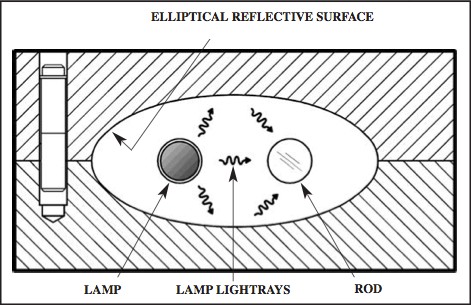Gold-plated laser cavities
 In most industrial Nd:YAG laser systems, the Nd:YAG crystal is housed in an assembly called a head. Usually consisting of a hollowed out block and removable lid, the head also houses the flashlamp or arclamp and some sort of reflective cavity (gold or ceramic) which directs the lamp light into the crystal.
In most industrial Nd:YAG laser systems, the Nd:YAG crystal is housed in an assembly called a head. Usually consisting of a hollowed out block and removable lid, the head also houses the flashlamp or arclamp and some sort of reflective cavity (gold or ceramic) which directs the lamp light into the crystal.
How They Work
Reflective cavities consist of a central cylinder, an elliptical cross section, and endplates which close the ends of the cylinder. The central cylinder can, in some cases, be separated into two halves like a clam shell. The rod and lamp are placed at the focal points of the ellipse to maximize the amount of lamp light directed into the rod.
A common cavity design, called “close coupled, ” simply positions the lamp as close as possible to the rod. In this arrangement, radiation directed from the lamp to the rod contributes more than just reflected radiation to the optical pumping of the rod.
Other Highlights
Most laser cavities are machined from metal. The surfaces are polished to a very smooth finish and plated with gold which is very reflective and resists corrosion. Repeated cleaning of contaminant deposits, however, results in scratches which reduce reflective efficiency.
When the reflective efficiency of a gold cavity has been reduced by corrosion and contaminant deposits, the cavity can often be salvaged and reworked. Corrosion and contaminants are chemically stripped, the reflective surface is repolished to original figure and quality, and a new gold plating is applied. This is economical for relatively large, expensive cavities. However, reworking is generally not cost effective for smaller cavities, which are usually manufactured in large batches, thus the set-up charges for reworking a small cavity will typically outweigh the material cost savings. Newer model Nd:YAG lasers are now incorporating cavities which have been machined from recently developed diffusely reflective, ceramic materials. These materials do not require gold plating and are more scratch resistant.
Cavity Assemblies

Cross section of an elliptical cavity
A great deal of research and development has gone into improving gold plating performance for laser cavity applications. Reflectivities above 98% are now routinely achieved. An underplating of nickel is often applied for improved corrosion resistance. Extra care is required to ensure this undercoating is pore-free, particle-free, and exceptionally uniform. The hardness and durability of the gold coating is increased by reducing the grain size through a unique grain refining process. This process does not require alloying; the gold is highly pure (99.9%) and, therefore, very corrosion resistant.
These process improvements have resulted in new and reworked cavities with reflectivity and longevity that in many cases exceeds the original design specifications.
